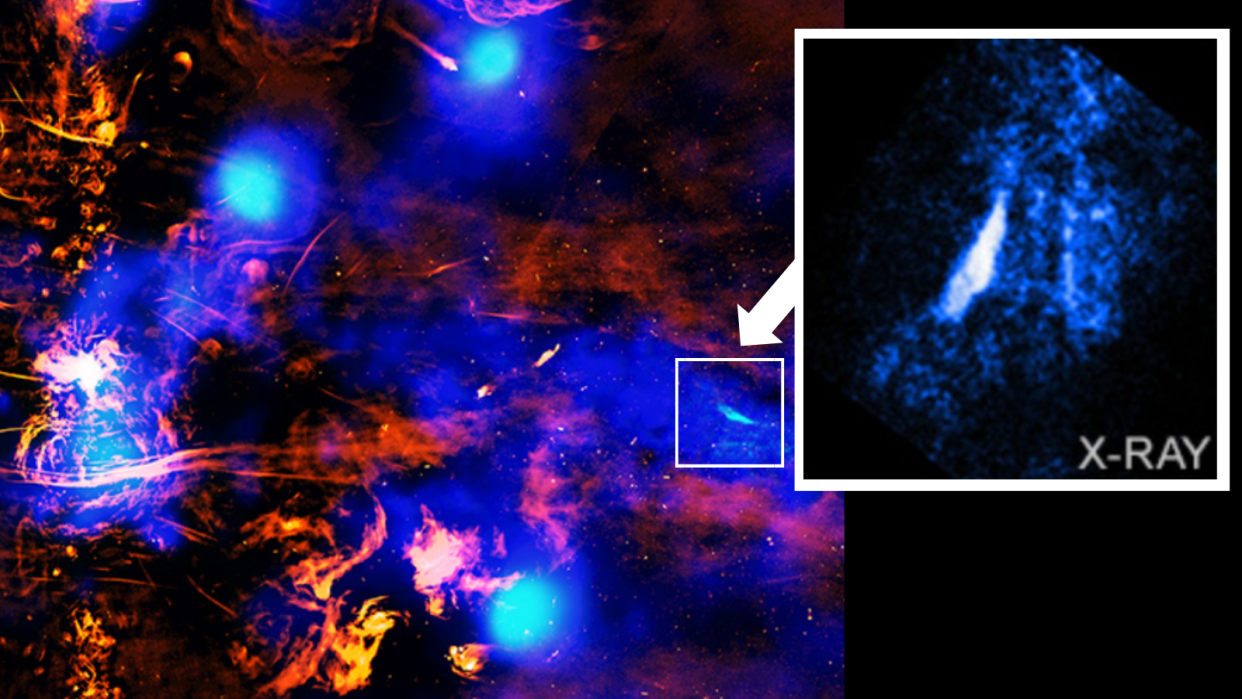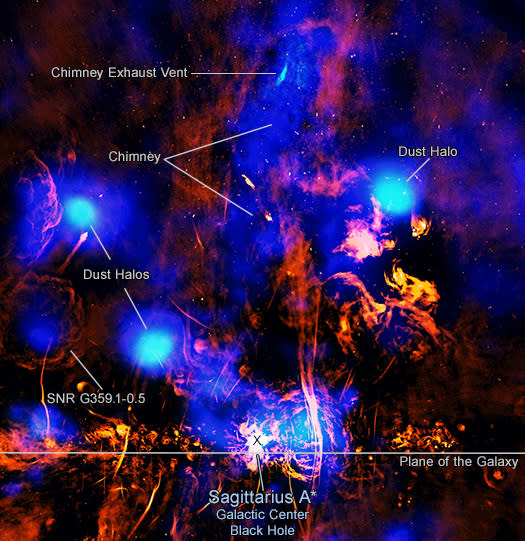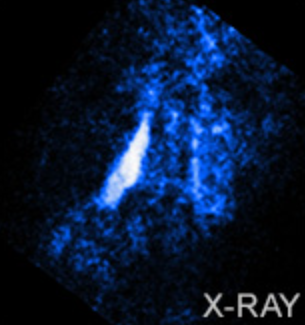NASA's Chandra spacecraft spots supermassive black hole erupting in the Milky Way's heart

Using NASA's Chandra X-ray space telescope, scientists have discovered a new cosmic "exhaust vent" funneling hot gas away from Sagittarius A* (Sgr A*), the supermassive black hole that sits at the very heart of our Milky Way galaxy.
The newly discovered vent is linked to a chimney-like formation orientated at a right angle in the Milky Way's disk. The Chandra observation reveals how a "tunnel" at the center of our galaxy helps channel matter to its outer regions.
Many supermassive black holes across the universe are voracious consumers of gas and dust, and even stars, around them. The supermassive black hole at the heart of the Milky Way, Sgr A*, on the other hand, is a light eater. It consumes so little matter, in fact, that if it were a human, it would sustain itself on about one grain of rice every one million years. The Chandra observations could reveal how this cosmic picky eater selects some matter to consume and rejects other material.
The vent discovered in X-ray observations of the Galactic Center by Chandra is located around 700 light-years from the region's exact central area, and at the top of the "chimney." This chimney was previously discovered using the European Space Agency (ESA) XMM-Newton, which, like Chandra, observes the universe in X-rays.
The image of the Galactic Center shows blue X-ray data from Chandra that's been enhanced by observations collected by the South African MeerKAT radio telescope, seen in red. This radio-wave data reveals the impact of magnetic fields that entrap the chimney's gas.

The new vent can be seen at the top of the image as a bright blue and white scar against darker blue gas.
In the enhanced image that contains only Chandra data white ridges of brighter X-rays appear. The team behind this research theorizes that these are the walls of a cylindrical tunnel through which hot gas moves upwards and away from Sgr A*, as well as away from its immediate surroundings.

The team behind these observations has an idea of how this exhaust vent was created. They think hot gas passing through the chimney impacts cooler gas in its way, creating shockwaves that lead to brighter X-ray vent walls. The researchers theorize that the left side of the vent appears brighter in the image than the right side does because the upward-moving hot gas hits the left side of the chimney wall more directly and, thus, with greater force.
As for where this jet of hot gas is coming from? Scientists think that, as material falls toward Sgr A*, the supermassive black hole erupts, and this pushes that matter up through the chimney and out along the vent. What remains to be determined, however, is just how frequently matter falls toward Sgr A*.
Related Stories
— How do some black holes get so big? The James Webb Space Telescope may have an answer
— Brightest quasar ever seen is powered by black hole that eats a 'sun a day'
—Fall into a black hole in mind-bending NASA animation (video)
Research conducted prior to these findings has suggested that Sgr A* and its surroundings in the Galactic Center experience dramatic X-ray flaring every few centuries. These X-ray flares could be an important part of the process that sees hot gas pushed away from Sgr A*.
Sgr A* also experiences much more infrequent feeding events that could play an important role in the whole gas-funneling process. Around every 20,000 years or so, the Milky Way's central supermassive black hole is believed to rip apart and devour an unfortunate star that has ventured too close to it.
These occurrences, called "tidal disruption events" or "TDEs," lead to the explosive release of tremendous amounts of energy that get channeled upwards through the black hole's chimney along with remaining stellar material from the shredded star that Sgr A* would reject as dessert.
A pre-peer-reviewed version of the team's Sgr A* research is available on the paper repository arXiv.

